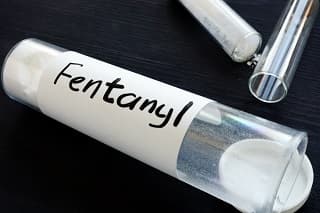 Fentanyl is a synthetic opioid drug which has gained a lot of notoriety around the country due to its contribution to high overdose rates in the US opioid crisis since 2017. Fentanyl is an opioid whose addiction characteristics are similar to those seen in oxycodone or heroin addiction. However, fentanyl comes with the caveat that it is around 50 times more potent than heroin and around 100 times more potent than morphine. Just a few grains of fentanyl powder can be the difference between a regular high and a lethal dose. Amounts are therefore much tougher for users to gauge, leading to higher overdose rates.
Fentanyl is a synthetic opioid drug which has gained a lot of notoriety around the country due to its contribution to high overdose rates in the US opioid crisis since 2017. Fentanyl is an opioid whose addiction characteristics are similar to those seen in oxycodone or heroin addiction. However, fentanyl comes with the caveat that it is around 50 times more potent than heroin and around 100 times more potent than morphine. Just a few grains of fentanyl powder can be the difference between a regular high and a lethal dose. Amounts are therefore much tougher for users to gauge, leading to higher overdose rates.
In recent years, fentanyl has increasingly been mixed with other drugs and sold as heroin, adding extra risk of overdose due to the variable strength in street drugs. Fentanyl is also often sold in the form of counterfeit prescription pills or laced into cocaine or other drugs.
Methods of Fentanyl Abuse
First synthesized for medical use in the 60’s, fentanyl’s medical applications include patches applied to the skin and lozenges (or ‘lollipops’) used for tightly restricted medical purposes. Like other opioid medications, fentanyl carries with it a high risk of dependence.
However, because fentanyl is cheaper and easier to produce than heroin, illicit labs often produce the drug and mix it with heroin in order to increase profit margins on illegal drug sales. This means that when abused, fentanyl is most often smoked, injected, or snorted. Another phenomenon is the rise of counterfeit opiate pills that actually contain fentanyl, which users take orally.
Fentanyl Abuse Side Effects on the Body
Similar to the adverse effects of other opiates, fentanyl binds to opioid receptors in the brain in a similar way to natural endorphins. Fentanyl also increases the brain’s production of the neurotransmitter dopamine, responsible for feelings of pleasure. These chemical changes in the brain create feelings of relaxation and euphoria in the user. Fentanyl’s chemical structure allows it to pass the blood-brain barrier more quickly than other opiates, which is what leads to its higher potency than other, more well-known opiates.
Side effects of fentanyl use include the classic side effects of opiate use, such as vomiting, dizziness, nausea, fainting, constipation, and difficulty urinating. Perhaps the most dangerous side effect of fentanyl is its tendency to produce a respiratory arrest in users. This is what leads to overdose, and it often comes quickly. Fentanyl overdoses can sometimes be reversed by administering doses of naloxone, if they are available in time for the user.
Fentanyl Abuse Signs and Symptoms
General symptoms of fentanyl use to watch for may include:
- User may appear unusually calm, relaxed, drowsy, or sleepy
- User may appear to fall asleep in place, and then wake up suddenly (“nodding out”)
- Constricted (small) pupils
- Slurred speech or jumbled words
- General confusion or disorientation
- Itchy eyes or skin
- Shallow breathing or other breathing problems
- Lowered heart rate and blood pressure
- Loss of appetite
- Sudden weight loss
Of course, we also recommend paying attention to any general signs and symptoms of drug abuse, such as possession of strange paraphernalia, using the bathroom for extremely long periods of time, or the person’s inability to recount where they were or what they were doing.
Fentanyl Abuse Withdrawal Symptoms
Fentanyl abuse withdrawal carries with it many of the same symptoms of other types of opioid withdrawal. Generally, fentanyl withdrawal (and opiate withdrawal in general) is not life-threatening. However, we always recommend being evaluated by substance abuse professionals or contacting a healthcare professional trained in addiction when deciding whether or not to seek medical detoxification services. Oftentimes, a drug abuser is using more than one drug, which can lead to complications in the detoxification process. Additionally, fentanyl users struggling with opioid dependence often find it nearly impossible to quit cold turkey and enter a cycle of residual relapse. Therefore, a medical detox program can be very helpful in making it through the early, unpleasant days of recovering from fentanyl addiction.
Symptoms of fentanyl addiction withdrawal:
- Vomiting
- Inability to fall sleep (often for a few days at a time)
- Loss of appetite
- Shivers and cold flashes
- Muscle and bone pains
- Cramping
- Involuntary movements
- Sweating
- Anxiety, depression, and irritability
- Diarrhea
- Runny nose and excessive sneezing
Next Steps – What to Do if Your Loved One is Struggling with Fentanyl Abuse or Addiction
If your teen or young adult may be struggling with fentanyl use – give us a call or contact us. The Pathway Program offers evaluations, referrals and treatment for young people and their families to get started on the path to recovering from all kinds of substance use disorders.




